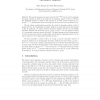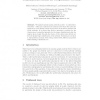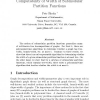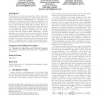IWOCA
2009
Springer
15 years 1 months ago
2009
Springer
: We present an improved upper bound of O(d1+ 1 m−1 ) for the (2, F)-subgraph chromatic number χ2,F (G) of any graph G of maximum degree d. Here, m denotes the minimum number of...
IWOCA
2009
Springer
15 years 1 months ago
2009
Springer
IWOCA
2009
Springer
15 years 1 months ago
2009
Springer
IWOCA
2009
Springer
15 years 1 months ago
2009
Springer
Embedded trees are labelled rooted trees, where the root has zero label and where the labels of adjacent vertices differ (at most) by
IWOCA
2009
Springer
15 years 1 months ago
2009
Springer
Abstract. We analyze special random network models – so-called thickened trees – which are constructed by random trees where the nodes are replaced by local clusters. These obj...
IWOCA
2009
Springer
15 years 1 months ago
2009
Springer
The notion of submodular partition functions generalizes many of well-known tree decompositions of graphs. For fixed k, there are polynomial-time algorithms to determine whether ...
IWOCA
2009
Springer
15 years 1 months ago
2009
Springer
The Feedback Vertex Set problem asks whether a graph contains q vertices meeting all its cycles. This is not a local property, in the sense that we cannot check if q vertices meet...
IWOCA
2009
Springer
15 years 1 months ago
2009
Springer
We discuss various questions around partitioning a split graph into connected parts. Our main result is a polynomial time algorithm that decides whether a given split graph is full...
ISSAC
2009
Springer
15 years 1 months ago
2009
Springer
We describe a new LLL-type algorithm, H-LLL, that relies on Householder transformations to approximate the underlying Gram-Schmidt orthogonalizations. The latter computations are ...
ISAAC
2009
Springer
15 years 1 months ago
2009
Springer
We study the following question, communicated to us by Mikl´os Ajtai: Can all explicit (e.g., polynomial time computable) functions f : ({0, 1}w )3 → {0, 1}w be computed by word...





